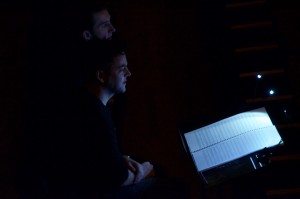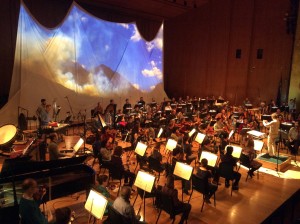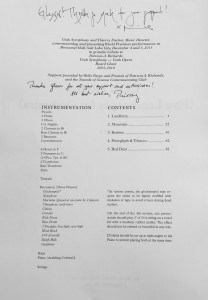In Sounds of Science Commissioning Club’s second commission with the Utah Symphony, Control (Five Landscapes for Orchestra) by Nico Muhly premiered in Abravanel Hall on December 4 and 5, 2015
Control (Five Landscapes for Orchestra), composed by Nico Muhly and with videography by Josh Higgason, is a sequence of five episodes describing, in some way, an element of Utah’s natural environment as well as the ways in which humans interact with it. This post describes the piece and several rehearsal snippets. For additional information, please see the KSL Channel 5 News piece, as well as the next blog post highlighting the preconcert interviews. This is the third of three Utah Symphony Commissions by award-winning, living American composers. A CD with Control by Nico Muhly, Eos by Augusta Read Thomas and Switch by Andrew Norman will be released on 75th anniversary CD in March 2016. Two of these – Switch and Control – were co-commissioned by SoSCC!
Program Notes from the Original Score
Landforms
The 1st part (Landforms) begins with a texture of strings, interrupted by forceful chords. A solo oboe works slowly on top of this process, and is itself interrupted by a progression of aggressive chords that slowly ascend, presented at two different (but close enough to rub together) speeds. These ascending forms become more seismically unstable, and a trio of pitched percussion (xylophone, marimba, and vibraphone) creates a more mathematical grid; here, as in many other places in Control, I tried to reference, however obliquely, the music of Olivier Messiaen (1908-1992), whose visionary work Des Canyons aux Étoiles (1972) deals with Utah’s landscapes and the spiritual possibilities found therein. The section ends as it began, but somehow changed, observed by the pitched percussion and subtly transformed.
Mountain
The 2nd part (Mountain) imagines a mountain in the summer, with various insect-like punctuations from the winds, and a heavily fragmented string section, with small groups of players and soloists splitting from the crowd. A solo viola and solo violin spin simple melodies under and over this texture, sometimes as plain as a single note displaced over all possible octaves. We end with a slightly ominous tuba and piano bass line suggesting, perhaps, that there are other uses for mountains that purely organic ones.
Beehive
Part 3 (Beehive) deals with Utah’s history of technological innovation being used to control the landscape. I tried, in various places, to use the orchestra to convey what must have been the pioneers’ shok at the wild shapes and colors of the landscape; here, that landscape is fully gridded, plotted, and divided and put to agricultural use. The key here is a productive busyness: Utah claims one of the first telegrams ever sent, and, more recently, some of the first fiber internet connections; industriousness is built into the pioneer wagons, the early plows, collective grain storage, charity, education, missionary work, and an ever-changing relationship to technology. Morse-code-like rhythms dominate the first half of this movement, and suddenly, a trio of trumpets take over, echoed by a trio off oboes, then flutes, then various chimes and bells. We end with a solo cello above a busy grid of triangles and woodblock.
Petroglyph and Tobacco
Part 4 (Petroglyph and Tobacco) begins with the simple, aggressive rhythms of stone-carving, hocketed between different families of the orchestra. Eventually, a melody emerges, a Ute song. It is too easy to project a romantic ancientness to the music of Native Americans; in this case, the song was used when begging for tobacco: post-European-contact evidence for modern malleability of Native American cultural traditions. Similarly, next to a petroglyph, we see modern graffiti, or graffiti from 90 years ago (Rulon Rushton, 1929, making his mark on history). The landscape and its inhabitants are in a constant dialogue.
Red Dirt
Part 5 (Red Dirt). I’ve spent a good deal of time in the St George area in southern Utah, and one of the most striking elements of the landscape is the outrageous red color everywhere; it’s visually inescapable. More notable, though, was the way the red dust permeated my hair, my clothes, my shoes, and the carpet in my motel. I flew to London the day after a long hike, and when I took off my socks, a confetti of red dust landed on the ground: the Utah landscape had followed me halfway around the world. We can control the landscape, but it has a way of reminding us of its permanence. This section turns a simple chord progression into clouds, shifting forms, and made of many moving parts.




